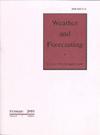将 WRF 模型中的网格间距从 3 公里改为 1 公里对模拟弓回声的影响
IF 3
3区 地球科学
Q2 METEOROLOGY & ATMOSPHERIC SCIENCES
引用次数: 0
摘要
利用气象研究和预报(WRF)模型,采用莫里森和汤普森微物理方案,以 3 千米和 1 千米的水平网格间距模拟了十次弓形回波事件,以确定细化网格间距对这种通常模拟不佳的对流模式的影响。模拟和观测的复合反射率被用来对对流模式进行分类。计算了技能分数,以量化模式预测所有模式的性能,并创建了一个新的弓形回波分数,以专门评估弓形回波预测的准确性。通过细化网格间距,使用汤普森方案运行的全形态得分明显提高,而莫里森运行的技能得分没有明显变化。不过,在细化网格间距后,使用这两种方案的运行的弓形回波得分都有所提高,其中汤普森方案的运行得分提高最为明显。此外,还对近暴风环境进行了分析,以了解为什么网格间距改变时模拟的弓形回波会发生变化。弓形回波的产生与冷池强度以及微物理冷却率的大小之间存在关系。在 1 千米的运行中出现了更多的上升气流,从而产生了更长的强对流线,在更多情况下更有可能演变成持续时间更长的弓形回波。大尺度特征,如与对流线和地表边界更加垂直的低空喷流方向,通常必须存在才能在 3 千米运行中出现弓形回波。本文章由计算机程序翻译,如有差异,请以英文原文为准。
The Impact on Simulated Bow Echoes of Changing Grid Spacing from 3 km to 1 km in the WRF Model
Ten bow echo events were simulated using the Weather Research and Forecasting (WRF) model with 3-km and 1-km horizontal grid spacing with both the Morrison and Thompson microphysics schemes to determine the impact of refined grid spacing on this often poorly simulated mode of convection. Simulated and observed composite reflectivity were used to classify convective mode. Skill scores were computed to quantify model performance at predicting all modes, and a new bow echo score was created to evaluate specifically the accuracy of bow echo forecasts. The full morphology score for runs using the Thompson scheme was noticeably improved by refined grid spacing, while the skill of Morrison runs did not change appreciably. However, bow echo scores for runs using both schemes improved when grid spacing was refined, with Thompson runs improving most significantly. Additionally, near storm environments were analyzed to understand why the simulated bow echoes changed as grid spacing was changed. A relationship existed between bow echo production and cold pool strength, as well as with the magnitude of microphysical cooling rates. More numerous updrafts were present in 1-km runs, leading to longer intense lines of convection which were more likely to evolve into longer-lived bow echoes in more cases. Large scale features, such as a low-level jet orientation more perpendicular to the convective line and surface boundaries, often had to be present for bow echoes to occur in the 3-km runs.
求助全文
通过发布文献求助,成功后即可免费获取论文全文。
去求助
来源期刊

Weather and Forecasting
地学-气象与大气科学
CiteScore
5.20
自引率
17.20%
发文量
131
审稿时长
6-12 weeks
期刊介绍:
Weather and Forecasting (WAF) (ISSN: 0882-8156; eISSN: 1520-0434) publishes research that is relevant to operational forecasting. This includes papers on significant weather events, forecasting techniques, forecast verification, model parameterizations, data assimilation, model ensembles, statistical postprocessing techniques, the transfer of research results to the forecasting community, and the societal use and value of forecasts. The scope of WAF includes research relevant to forecast lead times ranging from short-term “nowcasts” through seasonal time scales out to approximately two years.
 求助内容:
求助内容: 应助结果提醒方式:
应助结果提醒方式:


